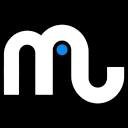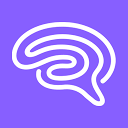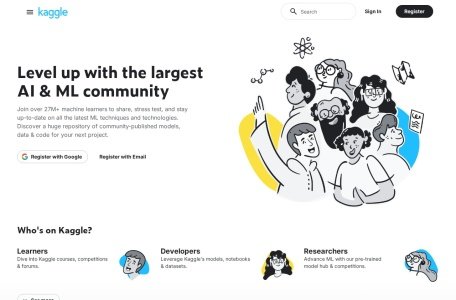
“Lack real datasets for AI practice? Struggle to find reference code for projects? Does winning competitions boost job prospects?” If these questions resonate, Kaggle might be your answer. Known as the “Data Science Olympics,” this platform has gathered over 25 million machine learning practitioners worldwide by 2025, hosting 508,000 high-quality datasets, 1.4 million reproducible notebooks, and 25,200 open-source models. From students practicing basics to enterprises like Google and Mercedes solving real-world problems, Kaggle has become the ultimate “hands-on training ground” for AI. This guide breaks down its core value, 2025 updates, and competition trends to help you master the platform.
I. What Kaggle Really Is: More Than Competitions—An AI Ecosystem Hub
Kaggle’s core appeal lies in “connecting data, code, and talent,” with its ecosystem covering three key scenarios:
- Learning: 70+ hours of free courses (from Python basics to large model fine-tuning), paired with beginner-friendly competitions like “Titanic Survival Prediction” to help new users get started quickly;
- Practice: Companies and research institutions post real-world challenges (e.g., Amazon rainforest monitoring, cervical cancer screening). Competitors submit models to compete for performance, with winners earning cash prizes or job offers;
- Resources: Datasets spanning 12 fields (finance, computer vision, NLP) — from 1-minute Bitcoin trading data to 4GB fruit image datasets — plus free GPU/TPU access for model training.
2025 data shows 83% of Top 50 tech companies review Kaggle competition winners, and gold medalists have a 3x higher resume acceptance rate than average applicants.
II. Core Resource Library: 3 Must-Use Sections in 2025
1. Datasets: 500K+ Options for All Skill Levels
Kaggle curates datasets by “Usability Score” — here are 4 trending ones in 2025 worth saving:
| Dataset Name | Size | Usability Score | Use Case |
|---|---|---|---|
| Bitcoin 1-Minute Trading Data | 100MB | 10.0 | Time series forecasting, quantitative analysis |
| Fruits-360 Image Dataset | 4GB | 8.8 | Image classification, transfer learning |
| International Football Match Results (1872-2025) | 1MB | 10.0 | Match prediction, feature engineering practice |
| Formula 1 Championship Data (1950-2024) | 7MB | 10.0 | Regression analysis, data visualization |
All datasets can be loaded directly into Kaggle Notebooks — no local storage required.
2. Notebooks: 1.4M Code Examples to Learn Modeling
Kaggle’s cloud-based Notebook environment supports mainstream frameworks (TensorFlow, PyTorch) and offers free GPUs (L4×4 configuration). The 3 most popular Notebook types in 2025:
- Large Model Practice: Implementations like Gemma 2 with Keras 3 (compatible with Jax/TensorFlow/PyTorch);
- Competition Recaps: 3,000+ posts from gold medalists sharing strategies (e.g., prompt engineering tips for SVG image generation competitions);
- Tool Tutorials: Hands-on cases for practical tools like Optuna hyperparameter tuning and SigLIP similarity calculation.
Beginners can fork (copy) high-star Notebooks and tweak parameters to reproduce results quickly.
3. Models: 25K+ Ready-to-Use Models
Kaggle Hub added a “One-Click Deployment” feature in 2025. Top models include:
- Reasoning: DeepSeek-R1 (zero-shot reasoning model with 89% accuracy on math problem-solving);
- Computer Vision: ConvNeXt (lightweight model with 30% fewer parameters than ResNet50 but higher precision);
- Multilingual: XLM-RoBERTa (supports text classification for 100+ languages).
III. 2025 New Feature: Kaggle Packages Redefines Competition Submissions
The biggest update this year — “Kaggle Packages” — completely changes how competitions are submitted:
Core Benefit: From “Script Submission” to “Model Packaging”
Previously, competitors needed to submit full code. Now, you only need to package a Model class with a predict() method — the platform automatically handles test set iteration and environment setup. Take the “Text-to-SVG Generation” competition as an example:
- Load a pre-trained model (e.g., Gemma 2) using
kagglehub; - Define a
Modelclass to convert text to SVG code; - After submission, the platform uses the SigLIP model to score similarity between generated images and descriptions.
This feature boosts code reusability by 60%, letting beginners iterate quickly using open-source Packages.
Usage Tips: Avoid These 3 Common Pitfalls
- Keep SVG files under 10KB and avoid CSS styling elements;
- Test locally with the official
kaggle_evaluationtoolkit before submission; - Disable external data calls — they cause errors during scoring.
IV. Competition Strategy: 2025 Tips for Beginners & Experts
1. For Beginners: Start with Playground Competitions
- Best Track: Tabular data competitions (e.g., house price prediction) — they rely on feature engineering (not heavy computing power), and XGBoost/LightGBM deliver strong results;
- Must-Read Resources: 100+ public Notebooks for the Titanic competition (learn missing value handling, target encoding, and other basics);
- Time Investment: 5 hours/week for 3 months to reach the Top 50%.
2. For Experts: Aim for $1M+ Prizes
Two top competitions to join in 2025:
▶ ARC Prize 2025 ($1M Prize Pool)
- Task: Build an AI model with ≥85% accuracy in abstract reasoning;
- New Rule: Open-source solutions are required for final scoring; computing power doubled from last year (L4×4s);
- Key Tip: Combine reinforcement learning with visual reasoning models to avoid overfitting.
▶ Google Gemma 3N Impact Challenge
- Focus: Use Gemma models to solve social issues (e.g., medical diagnosis assistance);
- Perk: Exclusive GPU resources — winning solutions join Google’s developer ecosystem.
3. Universal Winning Tips
| Task Type | Optimal Model Combination | Feature Engineering Focus |
|---|---|---|
| Tabular Data | XGBoost + CatBoost Ensemble | Target encoding for categorical variables, time feature splitting |
| Computer Vision | ResNet50 (small datasets) / ViT (large datasets) | Image augmentation, attention mechanism fine-tuning |
| NLP | BERT (short text) / LLaMA 2 (long text) | Word embedding visualization, noisy data cleaning |
V. Who Benefits Most? 3 Groups to Maximize Kaggle Value
1. Students: Build Practical Experience on a Budget
- Learning Path: Coursera Machine Learning Course → Kaggle Beginner Competitions → Publish Notebooks;
- Bonus: Join “Recruitment” competitions for direct interviews with companies like Facebook and Airbnb.
2. Professionals: A “Career Booster” for Transitions/Promotions
- Data Analysts: Practice with “International Football Match Prediction” to master Pandas visualization and regression;
- AI Engineers: Focus on “SVG Generation Competitions” to learn large model fine-tuning and engineering packaging.
3. Researchers: Validate Innovations Fast
Test new algorithms on Kaggle’s public datasets (e.g., validate improved U-Net models on lung cancer prediction datasets). The platform also supports one-click citation of datasets for academic papers.
VI. 2025 Pitfall Guide: 5 Lessons from Veteran Users
- Don’t Blindly Chase Large Models: In tabular competitions, XGBoost often outperforms Transformers — run a baseline model first, then optimize;
- Control Overfitting: ARC Prize 2025 added a semi-private leaderboard to prevent “gaming” public dataset scores;
- Maximize Free Computing Power: GPUs have a 12-hour daily limit — prioritize training large models overnight;
- Follow Community Discussions: The “Discussion” forum often hides hidden feature engineering tips;
- Backup Code Regularly: Notebooks auto-save but can be accidentally deleted — export to GitHub weekly.
Conclusion: Kaggle’s True Value — “Grow Through Practice”
The choice of 25 million users proves Kaggle is more than a competition platform — it’s an “accelerator for AI careers.” You don’t need deep theoretical knowledge: start with free datasets, join competitions, and get real feedback at every step.
If you’re stuck in the “learned AI but can’t apply it” phase, start with the Titanic competition or fork a Gemma model practice Notebook. After all, your first line of code on Kaggle could be the start of your AI career.
Relevant Navigation


AI University Hall

Tuanxiang (Formerly MitataAI)

Duipai AI Learning

Skywork

MuleRun

Snack Prompt

Originality.AI

